Print, The Comeback Kid
By Stephanie DelCarpio, Print Producer, Jana Youngblood, Studio Manager and Anne-Marie Zorad, Print Production Supervisor
What do you consider traditional advertising? Have you noticed a shift?
First, a little history lesson. The original staples of advertising were print, radio, and television. *The first newspaper ad was published in 1704 seeking a buyer for an Oyster Bay estate in the Boston News-Letter. Come 1922, the Queensboro Corporation buys the first commercials from AT&T’s radio station WEAF. Then, in 1941, NBC’s WNBT airs its first TV spot for a Bulova watch.
But, hold up. Let’s fast forward to now — the age of the internet! You can go to Starbucks for free Wi-Fi. People carry their laptops, iPads, and e-books to work, play, and read. We freak out if we forget our mobile devices at home. Oh, the terror!
Since the public birth of the World Wide Web in 1991, digital was poised to take advertising by storm. Blogging, web articles, and social media are critical formats to the success of any campaign now. Digital is everywhere. Digital advertising is the here and now. It’s not leaving anytime soon, thus making digital the traditional way to advertise now.
So, what does this mean? Did digital kill print advertising?
No! The goal for a successful brand is to differentiate from the competition. Now that digital advertising is the standard, we are forced to view and work with print in a whole new light — print advertising as the non-traditional method.
How can we leverage print in this digital world?
Leading up to the Presidental Elections, Twitter, a digitally-driven brand, began using out-of-home adverting as a new media. Jayanta Jenkins, Twitter’s global group creative director believes the OOH medium is “a really beautiful and powerful way to humanize tech brands… for us, [it] is a great way to get people to look up, off their devices, and remind them of the conversation that’s happening on Twitter. You can use less to say more.”



Twitter launched an out-of-home campaign featuring a series of social issue-themed outdoor ads
And Twitter isn’t the only tech brand that’s taking leaps into print. Airbnb.com, All Recipes, CNET.com, Net-a-Porter.com, and Dogster.com have included a non-traditional print medium to their strategies. This trend is not limited to digital companies, either. The TV industry is seeing the advantage of print with launches of Food Network and HGTV magazines.
Some advantages to print that these digitally-led companies see value in:
Tangible connectivity. Countless times we can be found in the magazine aisle reading about the latest news or gossip, and dabbing an alluring perfume scent from the print ad page. Or going to an amazing concert to wait 30 minutes in the merch line to purchase a poster or shirt that your favorite band printed. Print gives a personality to the brand, from touch to sight to smell. That connection resonates with people. Think about millennials and Gen Z’s; they have grown up with digital and missing much of that tactile experience. I-5 Publishing had this in mind when they purchased Catster and Dogster, web-based pet aficionados that showcase viral cats and dogs. They use higher quality paper, binding, and photography which appeals to the buyer’s experience.
Go offline. Omnipresence. (Pop-up) Buy this product! (Pop-up) Save lots of money! (Pop-up) Click now for details! The bombardment of digital ads can feel overwhelming. Connie Guglielmo, editor-in-chief of CNET news knows the importance of going offline, which helped push this tech website to make the transition into print. “People do like to decompress… shut off the screen and they like to read things in print.” Print allows you to look away, concentrate, and enjoy the experience, thus distancing itself from the distractions. With tech companies that have an imprint online already, print can heighten the omnipresence of online and offline.
Ad Blockers. In 2016, nearly 70 million US internet users installed ad blockers on their computers and mobile devices. It’s projected that 2017 will grow another 24% to 86 million users with ad blockers. According to Kantar Millward Brown’s latest AdReaction Report, people install ad blockers because digital ads are viewed as interruptive, annoying, slowing down their device, and irrelevant. The luxury of print is that there’s nothing to block it — brand and content will be seen.
Excitement. Wedding invitations. Birthday cards. Catalogs. Sure, you can receive all of these things digitally, but the exhilaration and joy you feel intensifies with a printed piece. Take for example the Ad Age 2016 Cannes Cover contest, for which Dieste’s Nicole Hamilton and Nicholas Ross created the winning design. “A Window Into the Creative Process – a 360 Experience” combined tactile print that folded into a VR viewer and kaleidoscope of digital illustrations and animations. The “design is joyous and engaging…for the first time in Ad Age, our cover is way more than a cover,” said Ad Age. It’s memorable. It’s a keepsake. It’s a great and lasting story.
We live in a digital world and we will continue to advance in digital advertising because it’s the new norm. But, step outside the box. Use a non-traditional method to promote your brands like Twitter did. Think print.








